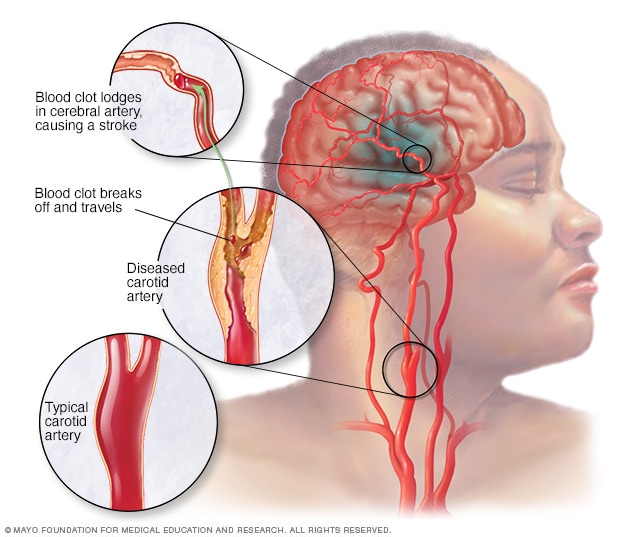A stroke occurs when the flow of blood to the brain is blocked, which is a medical emergency.
Blood carries oxygen, and without it, brain cells begin to die within minutes. Recognizing the signs of a stroke and seeking immediate treatment can save lives.
Types of Stroke:
- Ischemic Stroke: A blockage in an artery disrupts blood flow to the brain.
- Hemorrhagic Stroke: Blood leaks from a ruptured artery, compressing brain tissue.
- Transient Ischemic Attack (TIA): A temporary blockage of blood to the brain (also known as a ministroke).
Causes:
- Ischemic Stroke: Occurs when a blockage, often a blood clot, cuts off blood flow in the brain or carotid arteries.
- Hemorrhagic Stroke: Happens when an artery in the brain bursts or leaks blood.
- Transient Ischemic Stroke: Typically caused by a blood clot temporarily blocking blood flow.
Risk Factors:
- Heavy alcohol use
- Family history of stroke
- Physical inactivity
- High blood pressure
- High cholesterol
- Diabetes
- Overweight
- Heart disorders
Complications:
- Problems with speech and swallowing
- Seizures
- Loss of bowel control
- Emotional, mood, or behavioral changes
- Depression
- Dementia
- Sensory issues
- Bedsores
- Paralysis
Signs and Symptoms of Stroke:
- Sudden, severe headache
- Confusion or disorientation
- Trouble speaking or understanding speech
- Trouble seeing in one or both eyes
- Sudden numbness or weakness
- Dizziness, trouble walking, or loss of coordination
- Paralysis
- Nausea or vomiting
- Seizure
How Stroke Affects the Body:
- Severe headache
- Weakness
- Loss of coordination
- Paralysis
- Blurred vision
- Facial drooping
- Confusion
- Trouble speaking
Diagnosis:
A stroke is diagnosed based on symptoms, medical history, physical exam, and diagnostic tests. Tests may include:
- Carotid ultrasound or carotid angiography
- Echocardiogram
- Magnetic resonance imaging (MRI)
- Computed tomography (CT) scan
Treatment and Management:
Ischemic Stroke and TIA:
Since these strokes are caused by blood clots or blockages, treatments are similar:
- Mechanical thrombectomy (clot removal)
- Thrombolytics (clot-busting drugs)
- Stents to support weakened artery walls
- Surgery to remove plaque
- Aspirin or other blood thinners to prevent further clots
Hemorrhagic Stroke:
These strokes require different treatment strategies:
- Medication to reduce blood pressure, prevent seizures, and prevent blood vessel constriction
- Surgery to repair brain aneurysms (e.g., coiling or clipping)
- Craniotomy (surgical removal of part of the skull to relieve pressure)
Stroke Medication:
Common medications for stroke management include:
- Anticoagulants (blood thinners)
- tPA (tissue plasminogen activator), injected into a blood vessel to break up clots during a stroke
- Antiplatelet drugs
- Blood pressure medications
- Statins to lower high cholesterol and make it more difficult for blood to clot
- Direct-acting oral anticoagulants (DOACs)
Prevention:
- Get regular check-ups
- Maintain a healthy weight
- Quit smoking
- Limit alcohol consumption
- Exercise regularly
- Control blood pressure
- Manage diabetes
Conclusion:
In conclusion, a stroke is a serious medical emergency that occurs when blood flow to the brain is disrupted, leading to brain cell damage.
There are three main types of strokes: ischemic, hemorrhagic, and transient ischemic attacks (TIA).
Early recognition of symptoms and immediate medical attention are critical to reducing long-term damage. Managing risk factors such as high blood pressure, diabetes, and family history can help prevent strokes.
Treatment varies depending on the type of stroke, with medications and procedures aimed at restoring blood flow or managing bleeding.
Adopting healthy lifestyle choices and regular medical checkups can significantly reduce the likelihood of a stroke.

